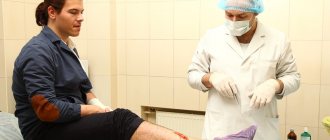Bleeding stops on its own in approximately 80% of cases. Continued bleeding requires stopping it endoscopically as soon as possible. If this is not possible, then resort to active surgical tactics. In some cases, endovascular intervention or conservative treatment is performed.
The main tasks assigned to an anesthesiologist-resuscitator in the treatment of patients with gastrointestinal tract:
- Carrying out the prevention of recurrent bleeding after it has stopped;
- Restoration of systemic hemodynamics and other indicators of homeostasis. Naturally, the volume of assistance provided can vary widely: from resuscitation measures to simple dynamic monitoring of the patient;
- Providing assistance during endoscopic intervention or surgical intervention (if necessary);
- Timely detection of recurrent bleeding;
- In relatively rare cases, conservative treatment of bleeding is performed.
Sequence of assistance
If the patient received anticoagulants before bleeding occurred, they should, in most cases, be discontinued. Assess the severity of the condition and the estimated amount of blood loss based on clinical signs. Vomiting blood, loose stools with blood, melena, changes in hemodynamic parameters - these signs indicate ongoing bleeding. Arterial hypotension in the supine position indicates large blood loss (more than 20% of the blood volume). Orthostatic hypotension (a decrease in systolic blood pressure above 10 mm Hg and an increase in heart rate by more than 20 beats per minute when moving to a vertical position) indicates moderate blood loss (10-20% of blood volume);
In the most severe cases, tracheal intubation and mechanical ventilation may be required before endoscopic intervention. Provide venous access with a peripheral catheter of sufficient diameter (G14-18); in severe cases, install a second peripheral catheter or perform catheterization of the central vein.
Take a sufficient volume of blood (usually at least 20 ml) to determine the group and Rh factor, combine blood and conduct laboratory tests: general blood count, prothrombin and activated partial thromboplastin time, biochemical parameters.
Hygiene as a prerequisite for successful recovery
It is no secret that compliance with hygiene standards, especially in the intimate area, is the key to the health of not only the woman herself, but also her partner and offspring. The rules of personal hygiene are learned in early childhood and subsequently must be strictly observed throughout life.
Expert opinion
Today, modern methods of maintaining natural cleanliness may differ significantly from those used by our mothers and grandmothers. Refusal of soaps with a high alkali content, the use of hypoallergenic sanitary pads, special compositions for treating the intimate area based on mild ingredients - all this ensures comfort and health for many years.
Obstetrician-gynecologist of the highest category Oksana Anatolyevna Gartleb
The Ginocomfort series of intimate hygiene products is not just detergent and soothing compositions - it is the result of long-term research, careful selection of components, strict compliance with the recipe and quality control. Using Gynocomfort intimate hygiene gels, you will forget about irritation, provide powerful antibacterial protection to the body and comfort for a long time. This is especially important for uterine bleeding caused by myomatous formations. The secreted blood is a breeding ground for a large number of bacteria. It quickly coagulates, an unpleasant odor appears, hyperemia appears on the skin and mucous membranes, a burning sensation occurs, and pustular lesions appear.
To eliminate discomfort from uterine bleeding and prevent bacterial infection, you should use the following products from the popular Gynocomfort series:
- Revitalizing intimate gel - suitable for eliminating vaginal discomfort. Restores the natural balance of the skin in the intimate area and the microflora of the mucous membrane after suffering from inflammatory diseases.
- Washing gel for intimate hygiene “Basic care” - provides comfort and safety, is suitable for daily use and does an excellent job of protecting against the development of pathogenic microflora on the vaginal mucosa.
All Gynocomfort products are great for women of any age and with any health condition, can be combined with any therapy and are indispensable during the recovery period.
Intimate gel for women's health
Infusion therapy
Begin infusion therapy with the introduction of balanced salt solutions.
Important! If there are signs of ongoing bleeding or unstable hemostasis has been achieved, blood pressure should be maintained at the minimum acceptable level (SBP 80-100 mm Hg), i.e. infusion therapy should not be too aggressive. Blood transfusions are carried out if adequate infusion therapy fails to stabilize the patient’s hemodynamics (blood pressure, heart rate). Consider the need for blood transfusion:
– when the hemoglobin level decreases below 70 g/l. when bleeding has stopped;
– with ongoing bleeding, when hemoglobin is below 90-110 g/l.
In case of massive blood loss (more than 50-100% of the blood volume), transfusion treatment is carried out in accordance with the principles of “Hemostatic resuscitation”. It is believed that each dose of packed red blood cells (250-300 ml) increases hemoglobin levels by 10 g/l. Fresh frozen plasma is prescribed for clinically significant coagulopathy, including drug-induced coagulopathy (for example, the patient is receiving warfarin). And in case of massive blood loss (>50% of blood volume). If reliable hemostasis is achieved, there is no need to administer FFP even with significant blood loss (more than 30% of the blood volume). Dextrans (polyglucin, rheopolyglucin), hydroxyethyl starch (HES) solutions may increase bleeding and their use is not recommended.
How to stop nosebleeds in young children
- to begin with, the child must be seated so that the blood can flow out freely;
- Ice should be placed on the bridge of the nose, neck or forehead. If it is not there, you can take any cold product from the refrigerator. Your feet should be warm at this time;
- Press the wing of the nostril from which the blood is coming out against the septum for 15 seconds. During this time, the bleeding should stop;
- if the bleeding is heavy, place a tampon soaked in a small amount of hydrogen peroxide (just salt water will do) in the nostril, or use vasoconstrictor drops.
To prevent this condition, it is important for the child to spend more time in the fresh air (in any weather). Swimming and hardening are great for strengthening blood vessels. Periodically humidify the air in the room where the child spends most of the time. It is important that his diet is varied and contains all the necessary microelements and vitamins. In young children, nosebleeds are often caused by frequent nose picking. Make sure your child doesn't do this. If the cause of the problem is physical activity, it is necessary to review the baby’s daily routine and reduce it.
Antisecretory therapy
Optimal conditions for the implementation of vascular-platelet and hemocoagulation components of hemostasis are created at pH > 4.0. Proton pump inhibitors and H2-histamine receptor blockers are used as antisecretory drugs.
Attention! It is not advisable to prescribe H2-histamine receptor blockers and proton pump inhibitors at the same time.
Medicines of both groups suppress the production of hydrochloric acid in the stomach and thereby create conditions for stable hemostasis of the bleeding vessel. But proton pump inhibitors show more consistent results in reducing gastric acidity and are significantly more effective in reducing the risk of recurrent bleeding. The antisecretory effect of proton pump inhibitors is dose-dependent. Therefore, the use of high doses of drugs is currently recommended, so the prescription regimens indicated below are not a typo by the author.
Patients are prescribed an intravenous infusion of one of the following proton pump inhibitors:
- Omeprazole (Losec) 80 mg IV as a loading dose, followed by 8 mg/hour.
- Pantoprazole (Controloc) 80 mg IV as a loading dose, followed by 8 mg/hour.
- Esomeprazole (Nexium) 80 mg IV as a loading dose, followed by 8 mg/hour.
The loading dose of the drug is administered in approximately half an hour. Intravenous administration of the drug is continued for 48-72 hours, using, depending on possibilities, a bolus or continuous route of administration. In the following days, they switch to oral administration of the drug at a daily dose of 40 mg (for all of the proton pump inhibitors listed in this paragraph). The approximate duration of the course is 4 weeks.
Attention. The administration of proton pump inhibitors should be started before endoscopic intervention, as this reduces the likelihood of recurrent bleeding.
In the absence of proton pump inhibitors, or patients intolerant of them, intravenous H2-histamine receptor blockers are prescribed:
- Ranitidine 50 mg IV every 6 hours or 50 mg IV followed by 6.25 mg/hour IV. After three days, 150-300 mg orally 2-3 times a day;
- Famotidine 20 mg IV drip every 12 hours. Orally for treatment use 10-20 mg 2 times/day or 40 mg 1 time/day.
Causes of nosebleeds
Take a look at this list. Each of the points can cause nosebleeds.
- overheating of the body;
- avitaminosis;
- decreased blood clotting;
- weak blood vessels;
- nasal injury;
- inflammatory processes in the nasal passage;
- high blood pressure;
- pathologies of the cardiovascular system;
- existing serious diseases, for example: leukemia or anemia;
- decreased level of platelet production in the body;
- taking medications;
- the presence of a tumor in the nasal passage.
Preparation for gastroscopy
After relative stabilization of the patient’s condition (SBP more than 80-90 mm Hg), it is necessary to conduct an endoscopic examination, and, if possible, determine the source and stop the bleeding.
The following procedure can facilitate gastroscopy against the background of ongoing bleeding. 20 minutes before the intervention, the patient is given intravenous erythromycin by rapid infusion (250-300 mg of erythromycin is dissolved in 50 ml of 0.9% sodium chloride solution and administered over 5 minutes). Erythromycin promotes rapid evacuation of blood into the intestine, and thereby facilitates the identification of the source of bleeding. With relatively stable hemodynamics, 10 mg metoclopramide is used intravenously for the same purposes.
In patients with valvular heart disease, antibiotic prophylaxis is recommended before performing gastroscopy. Sometimes, to remove blood clots from the stomach (to facilitate endoscopic examination), a large-bore gastric tube (24 Fr or larger) must be inserted. It is recommended to lavage the stomach with water at room temperature. After the procedure is completed, the probe is removed.
Using a gastric tube for the purpose of diagnosing and controlling bleeding (if endoscopic examination is possible), in most cases, is considered inappropriate.
What to do if you have a nosebleed
The first step is to determine how serious the situation is. Pay attention to when the bleeding occurred and how intense it is. It happens that the blood drips a little and stops by itself. It is also possible to stop minor bleeding on your own. If the bleeding is heavy and is accompanied by other signs (serious damage to the skin, fainting, darkening of the eyes, hysteria or increased blood pressure) or the bleeding is complicated by chronic diseases of the blood or cardiovascular system, you must urgently call an ambulance and follow the instructions of the telephone operator before arrival doctor
Self-medication is dangerous
Any dysfunctional uterine bleeding requires observation and intervention by a gynecologist. Only a professional doctor will be able to accurately diagnose the cause of the disease, competently build a treatment strategy, taking into account diagnostic studies and consultation recommendations of specialized specialists. An experienced diagnostic and treatment gynecologist will be able to prescribe treatment not for one organ, but for the entire body as a whole. Ignoring symptoms and incorrect diagnosis can lead to the development of cancer. Timely diagnosis, taking into account the frequency and intensity of uterine bleeding, the latest equipment, highly qualified personnel - all this will help carry out treatment and restore women's health to the patient, regardless of her age.











